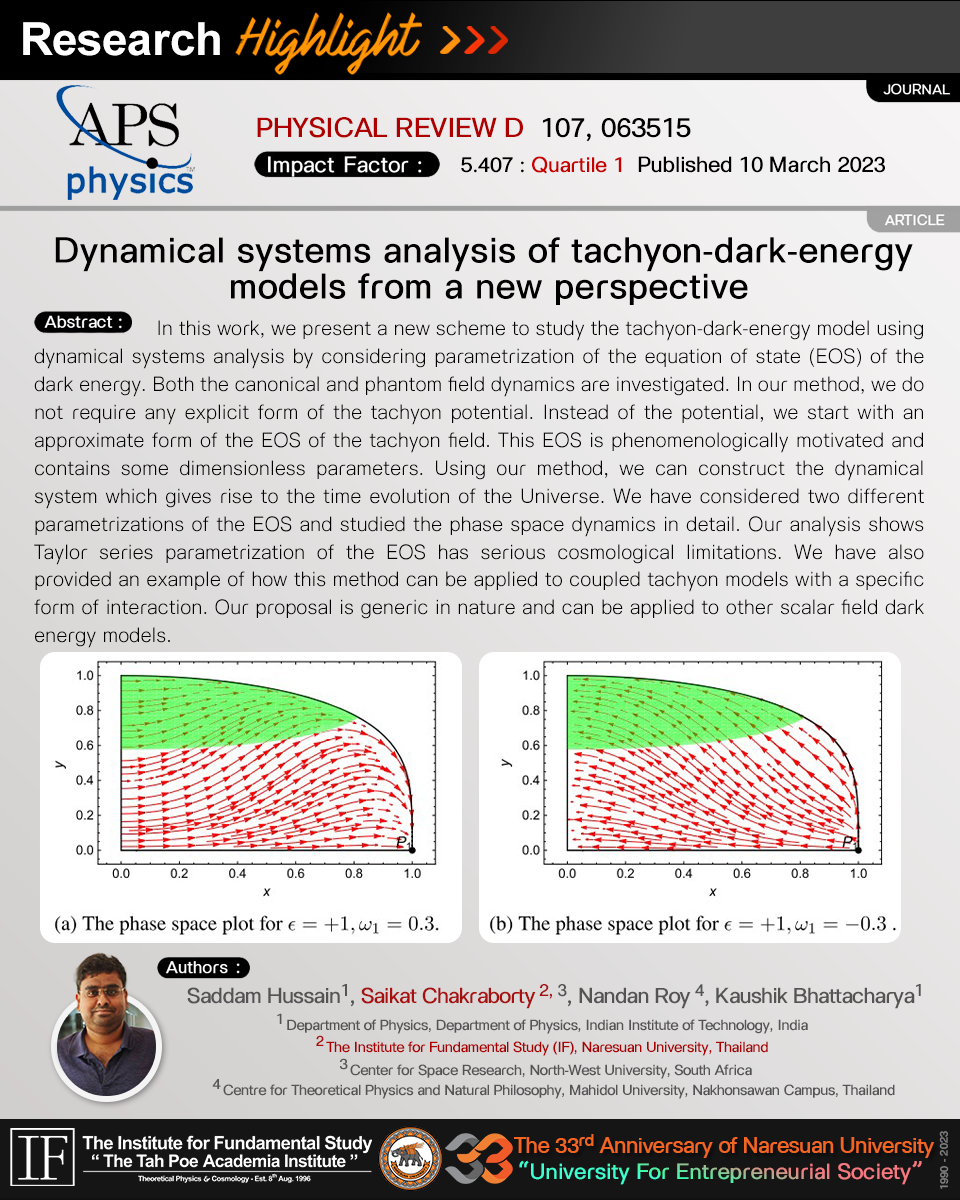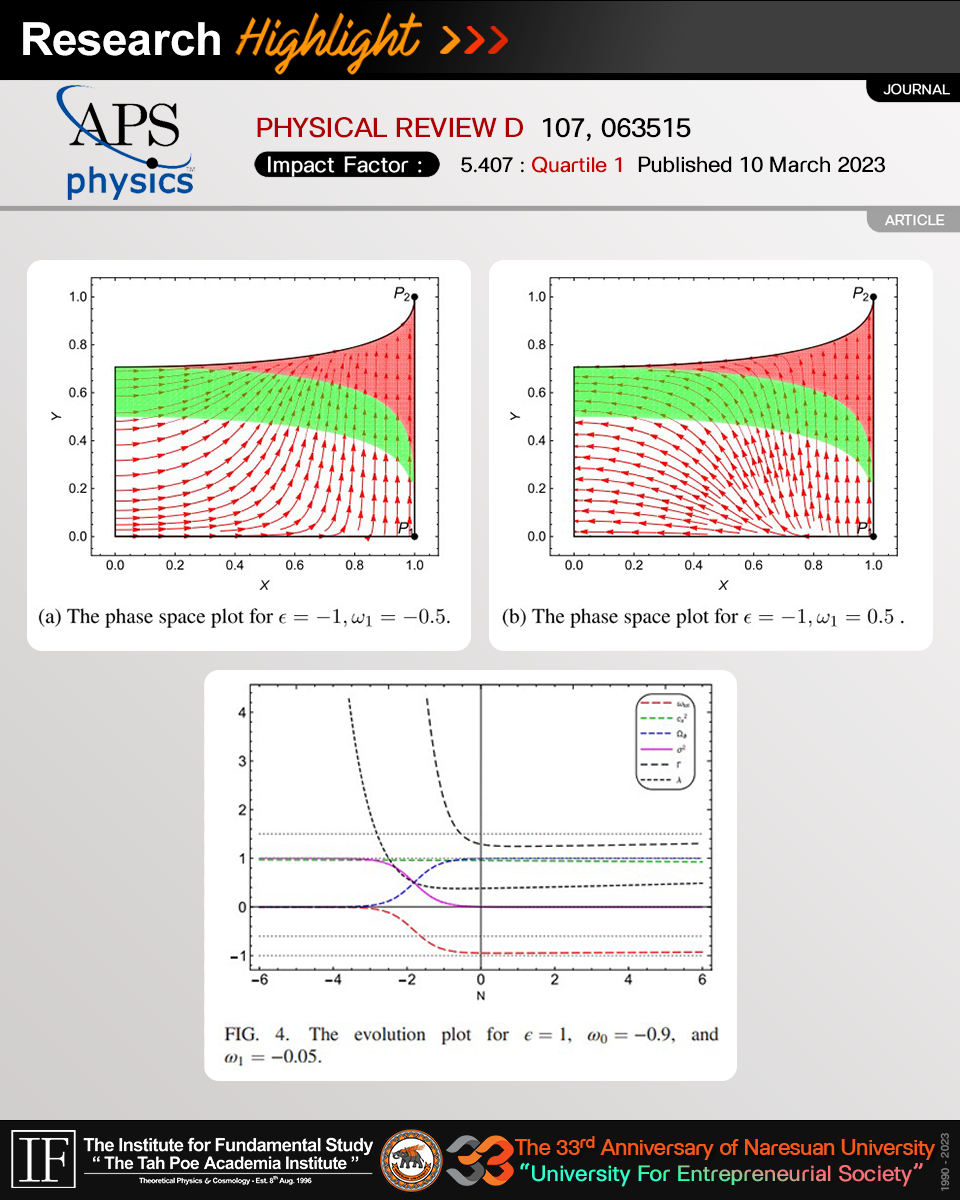
 #ResearchHighlight
#ResearchHighlight
🛎 Dynamical systems analysis of tachyon-dark-energy models from a new perspective
📌 Authors: Saddam Hussain*, Saikat Chakraborty**,***, Nandan Roy****, and Kaushik Bhattacharya*
*Department of Physics, Indian Institute of Technology, India
**The Institute for Fundamental Study “The Tah Poe Academia Institute”, Naresuan University, Thailand
***Center for Space Research, North-West University, South Africa
****Centre for Theoretical Physics and Natural Philosophy, Mahidol University, Nakhonsawan Campus, Thailand
📌 ความสำคัญและที่มา
ในงานนี้ เรานำเสนอโครงร่างใหม่เพื่อศึกษาแบบจำลองพลังงานมืด tachyon โดยใช้การวิเคราะห์ระบบไดนามิกโดยพิจารณาการกำหนดพารามิเตอร์ของสมการสถานะ (EoS) ของพลังงานมืด มีการตรวจสอบทั้งไดนามิกของฟิลด์ Canonical และ Phantom ในวิธีการของเรา เราไม่ต้องการรูปแบบที่ชัดเจนของศักยภาพ tachyon แทนที่จะเป็นศักยภาพ เราเริ่มต้นด้วยรูปแบบโดยประมาณของ EoS ของฟิลด์ tachyon EoS นี้ได้รับแรงบันดาลใจจากปรากฏการณ์วิทยาและมีพารามิเตอร์ไร้มิติบางตัว โดยใช้วิธีการของเรา เราสามารถสร้างระบบไดนามิกซึ่งก่อให้เกิดวิวัฒนาการทางเวลาของเอกภพ เราได้พิจารณาสองพารามิเตอร์ที่แตกต่างกันของ EoS และศึกษาไดนามิกของเฟสสเปซอย่างละเอียด การวิเคราะห์ของเราแสดงให้เห็นว่าการจัดพารามิเตอร์อนุกรมเทย์เลอร์ของ EoS มีข้อจำกัดทางจักรวาลวิทยาอย่างร้ายแรง เรายังให้ตัวอย่างว่าวิธีนี้สามารถนำไปใช้กับโมเดล Tachyon ที่จับคู่กับรูปแบบการโต้ตอบเฉพาะได้อย่างไร ข้อเสนอของเรามีลักษณะทั่วไปและสามารถประยุกต์ใช้กับแบบจำลองพลังงานมืดของสนามสเกลาร์อื่นๆ
📌 ผลสัมฤทธิ์สำคัญ
– เรานำเสนอวิธีการสร้างสมการพลังงานมืดเชิงปรากฏการณ์วิทยาของพารามิเตอร์สถานะใหม่เป็นข้อจำกัดเกี่ยวกับพีชคณิตเหนือสเปซเฟสจักรวาลวิทยา ซึ่งจำกัดไดนามิกของเฟสสเปซ
– เราแสดงให้เห็นว่าแนวทางของเราสามารถขยายไปยังกรณีที่มีปฏิสัมพันธ์ระหว่างสสารมืดและพลังงานมืดได้
– เราแสดงให้เห็นว่าการตั้งค่าสถานะสมการพลังงานมืดแบบอนุกรมของเทย์เลอร์เข้ากันไม่ได้กับแบบจำลองพลังงานมืดแบบเร็ว
📌 Motivation and background
In this work, we present a new scheme to study the tachyon dark energy model using dynamical systems analysis by considering parametrization of the equation of state(EoS) of the dark energy. Both the canonical and phantom field dynamics are investigated. In our method, we do not require any explicit form of the tachyon potential. Instead of the potential, we start with an approximate form of the EoS of the tachyon field. This EoS is phenomenologically motivated and contains some dimensionless parameters. Using our method we can construct the dynamical system which gives rise to the time evolution of the universe. We have considered two different parametrizations of the EoS and studied the phase space dynamics in detail. Our analysis shows Taylor series parametrization of the EoS has serious cosmological limitations. We have also provided an example of how this method can be applied to coupled Tachyon models with a specific form of interaction. Our proposal is generic in nature and can be applied to other scalar field dark energy models.
📌 Key results
– We present a way to recast a phenomenological dark energy equation of state parameter as an algebraic constraint over the cosmological phase space, which constrains the phase space dynamics.
– We show that our approach can also be extended to the case when there is an interaction between dark matter and dark energy.
– We show that Taylor series parametrization of dark energy equations state is not compatible with tachyonic dark energy models.
📌 Journal :
https://journals.aps.org/prd/abstract/10.1103/PhysRevD.107.063515
#CGL #IFNU #PhysicsNaresuan
